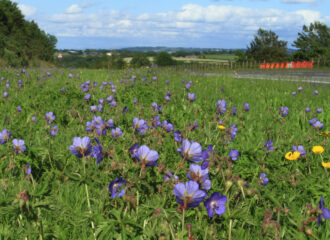Road verges offer an insight to the how the Welsh countryside looked in the past – in much the same way as brownfield sites tell us something about historical work places. In the relatively few remaining places where road verges have not been subjected to intensive management and over-cutting, the flora of the road-verges gives us a glimpse of the historic flora of the fields behind the road. Typically, these were flower-rich meadows that have been reseeded either as species-poor permanent pastures dominated by perennial rye grass (Lolium perenne) and white clover (Trifolium repens) or been replaced with species-poor silage crops, again typically dominated by perennial rye grass. A brief outline of favourable and unfavourable road verge states are provided in the sections below.
Road verges

Reference state – Road verges
The reference state for road verges is similar to that for semi-natural and species-rich hay meadow meadow vegetation, where grasses form less than 50% of the vegetation cover. Species such as bird’s-foot trefoil (Lotus corniculatus), which has disappeared from many meadows as a consequence of nitrogenous fertiliser applications, can be abundant in the better road…

Modified state – Road verges
The modified states of road verge are species-poor grass-dominated verges that have been reseeded, under-managed or over-managed. Consecutive years of not not cutting will lead to the increased dominance of tall and rank grass species, while cutting several times each summer, starting in May and then often monthly throughout the summer. This will prevent the…

